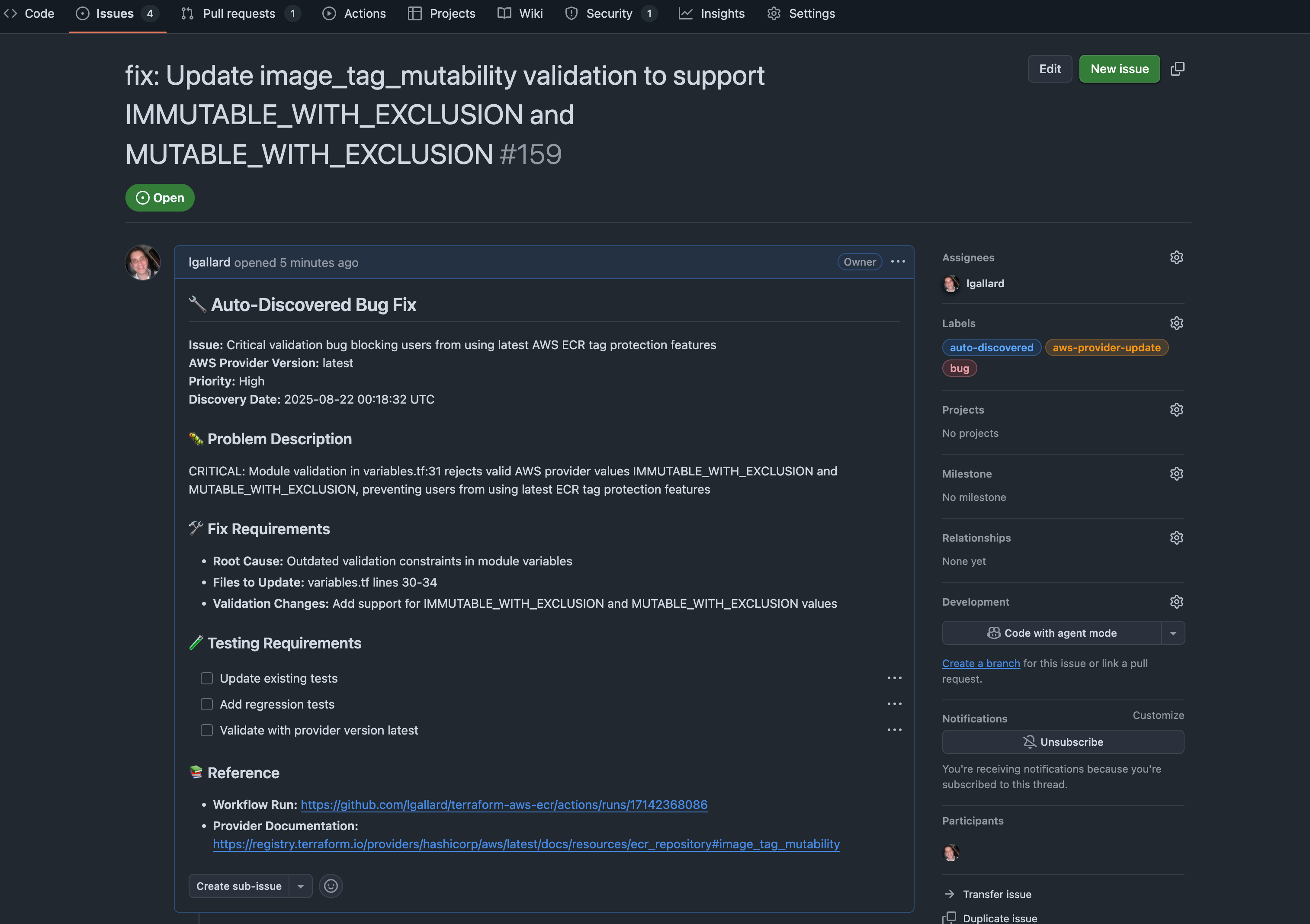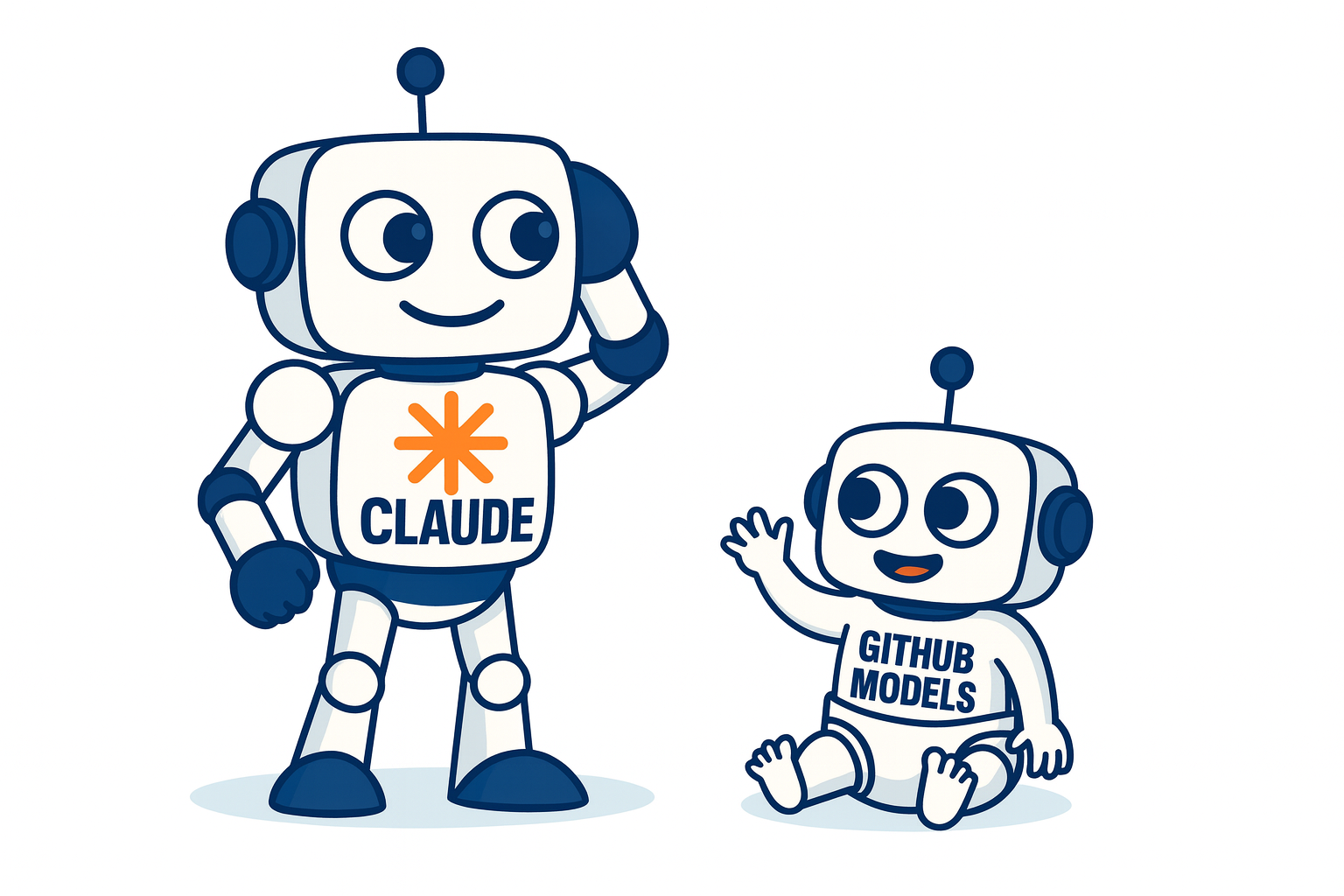Automating Terraform Module Discovery with Claude Code GitHub Actions

As a maintainer of several Terraform modules, I’ve always faced the challenge of keeping up with AWS provider updates. New features are constantly being added, and manually tracking these changes across dozens of resources is both time-consuming and error-prone. What if I could automate this process entirely?
That’s exactly what I did with my terraform-aws-ecr module, creating an intelligent discovery system using Claude Code and GitHub Actions that automatically identifies missing features, creates issues, and even proposes fixes. The results have been remarkable.
🎯 The Challenge: Staying Current with AWS Provider Updates
Managing Terraform modules at scale presents unique challenges:
- Constant Evolution: AWS releases new features regularly, and the Terraform AWS provider must catch up
- Manual Overhead: Checking for new resources, attributes, and validation rules is tedious
- Discovery Lag: By the time you notice a missing feature, users may have already encountered limitations
- Quality Assurance: Each update requires careful testing and validation
For my ECR module specifically, AWS Container Registry has evolved significantly with new security features, lifecycle policies, and tag protection mechanisms. Keeping the module current while ensuring backward compatibility requires constant vigilance.
🚀 The Solution: Automated Feature Discovery with Agentic Workflows
I implemented an automated system that:
- Monitors the AWS provider for ECR-related updates
- Analyzes the current module implementation against latest provider capabilities
- Identifies gaps and potential improvements
- Creates detailed GitHub issues with fix requirements
- Proposes solutions when possible
The architecture leverages Claude Code’s GitHub Actions integration to create what I call “agentic workflows” - autonomous systems that can reason about code, identify problems, and propose solutions.
🛠️ Implementation: GitHub Actions + Claude Code
Here’s a conceptual overview of the workflow structure:
name: ECR Module Feature Discovery
on:
schedule:
- cron: '0 0 * * 1' # Weekly on Mondays
workflow_dispatch:
jobs:
discover-features:
runs-on: ubuntu-latest
steps:
- uses: actions/checkout@v4
- name: Run Claude Code Discovery
env:
ANTHROPIC_API_KEY: $
GITHUB_TOKEN: $
run: |
claude-code analyze-terraform-module \
--provider hashicorp/aws \
--resource-type aws_ecr_repository \
--module-path . \
--create-issues \
--auto-fix-safe
Production Workflow Configuration
The actual production implementation uses the Claude Code GitHub Action with comprehensive MCP server integration:
name: ECR Feature Discovery
on:
schedule:
- cron: '12 21 * * *'
workflow_dispatch:
inputs:
provider_version:
description: 'AWS Provider version to check (default: latest)'
required: false
default: 'latest'
type: string
dry_run:
description: 'Run analysis without creating issues'
required: false
default: false
type: boolean
jobs:
discover-ecr-features:
runs-on: ubuntu-latest
timeout-minutes: 30
permissions:
contents: write
issues: write
pull-requests: read
steps:
- name: Checkout repository
uses: actions/checkout@v4
- name: Run Claude Code Feature Discovery
uses: anthropics/claude-code-action@beta
env:
GITHUB_TOKEN: $
with:
claude_code_oauth_token: $
# MCP Configuration for documentation access
mcp_config: |
{
"mcpServers": {
"terraform": {
"command": "npx",
"args": ["-y", "@modelcontextprotocol/server-terraform@latest"]
},
"context7": {
"command": "npx",
"args": ["-y", "@upstash/context7-mcp@latest"]
}
}
}
# Direct prompt for comprehensive feature discovery
direct_prompt: |
# ECR Feature Discovery Analysis
Analyze the latest AWS provider ECR resources and compare them with
the current module implementation to identify:
1. New Features: ECR resources/arguments not yet implemented
2. Deprecations: Features marked as deprecated in the provider
3. Bug Fixes: Important fixes mentioned in provider changelogs
Use Terraform MCP server to get latest ECR documentation, analyze
current module implementation, and create detailed GitHub issues
for significant findings with comprehensive implementation guidance.
mode: agent
The key differences in the production version:
- MCP Servers: Integrates Terraform and Context7 for real-time documentation access
- Advanced Inputs: Supports dry-run mode, provider version specification, and force scanning
- Comprehensive Analysis: Uses a detailed prompt that performs multi-step analysis
- Feature Tracking: Maintains a JSON database of discoveries and scan history
- Intelligent Issue Creation: Generates detailed issues with specific implementation guidance
The magic happens in the Claude Code analysis, which:
- Fetches the latest AWS provider documentation
- Compares current module variables and outputs
- Identifies missing attributes, validation rules, and best practices
- Generates comprehensive issues with implementation details
🔍 First Real-World Discovery: ECR Tag Protection
The system’s first major finding was a critical validation bug that had been preventing users from leveraging AWS ECR’s latest tag protection features.

The Problem: The module’s validation logic only accepted IMMUTABLE and MUTABLE values for image_tag_mutability, but AWS had introduced two new options:
IMMUTABLE_WITH_EXCLUSIONMUTABLE_WITH_EXCLUSION
The Discovery: Claude Code analyzed the AWS provider documentation, compared it with the module’s validation constraints, and immediately identified the discrepancy.
The Solution: PR #160 was automatically generated with:
- Updated validation rules
- Documentation improvements
- Test cases for the new values
- Backward compatibility verification
This single discovery prevented potential user frustration and demonstrated the system’s effectiveness in real-world scenarios.
📊 Five Practical Agentic Workflow Scenarios
Based on my experience, here are five powerful scenarios where agentic workflows can transform your repository management:
1. Issue Triage and Labeling
Scenario: Automatically categorize and prioritize incoming issues.
Workflow Description: “On every new issue, read the issue description and comments, summarize the main problem, assign relevant labels based on content analysis, and suggest appropriate maintainers for review.”
Implementation:
on:
issues:
types: [opened]
jobs:
triage:
runs-on: ubuntu-latest
steps:
- name: Analyze Issue
run: |
claude-code triage-issue \
--issue-number $ \
--assign-labels \
--suggest-assignees \
--create-summary
Benefits: Reduces manual triage time by 80%, improves response times, ensures consistent labeling.
2. Continuous Documentation Updates
Scenario: Keep documentation synchronized with code changes automatically.
Workflow Description: “Whenever code is pushed to the main branch, analyze the changes, review existing documentation for accuracy, identify outdated sections, and create pull requests with suggested improvements.”
Real Example: After adding new ECR lifecycle policy variables, the system automatically updated the README with proper examples and variable descriptions.
Implementation Focus:
- Module variable documentation generation
- Example configuration updates
- API reference synchronization
3. Accessibility Review
Scenario: Ensure code and documentation meet accessibility standards.
Workflow Description: “Periodically scan the repository for accessibility issues in documentation, code comments, and user-facing outputs. Create actionable issues with specific improvement suggestions.”
Terraform Context: Particularly valuable for:
- Output descriptions clarity
- Variable naming conventions
- Error message readability
- Documentation structure
4. Continuous Test Improvement
Scenario: Enhance test coverage based on code changes and real usage patterns.
Workflow Description: “After each merge, analyze the coverage report and code differences, identify untested code paths, propose new test cases to improve coverage, and create pull requests with suggested test implementations.”
ECR Module Example: The system identified that new tag protection features lacked integration tests and automatically generated test cases covering edge scenarios.
5. Continuous QA and Code Enhancement
Scenario: Proactively identify potential bugs and code improvements.
Workflow Description: “On every pull request, analyze the code for potential issues, suggest additional safety checks, recommend Terraform best practices, and create follow-up issues for broader improvements.”
Key Focus Areas:
- Resource naming conflicts
- Security policy gaps
- Variable validation improvements
- Output formatting consistency
🌟 The Future of Infrastructure Automation
This experiment has convinced me that agentic workflows represent the future of infrastructure management. The combination of Claude Code’s reasoning capabilities with GitHub’s automation platform creates possibilities that seemed like science fiction just a few years ago.
The key insight is that we’re not replacing human judgment—we’re augmenting it. The system handles the tedious, repetitive analysis work, freeing us to focus on architectural decisions, user experience, and strategic planning.
Want to explore more about Claude Code and agentic workflows? Check out my previous post on MCP servers for research-driven development or follow my experiments on GitHub.




